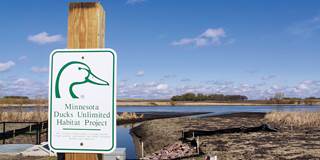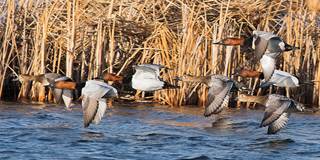The Clean Water Connection
DU's work to restore shallow prairie lakes and wetlands provides improved habitat and cleaner water for wildlife and people
DU's work to restore shallow prairie lakes and wetlands provides improved habitat and cleaner water for wildlife and people
By Jennifer Boudart
Since 2004, DU's Living Lakes Initiative has successfully enhanced and restored key wetland and shallow lake habitats in the Prairie Pothole Region of Iowa and Minnesota. Nearly all the native grasslands and at least 90 percent of the prairie potholes in those states have been converted to other land uses. The wetlands that remain are primarily large marshes and shallow lakes that are less than 15 feet deep. These remaining wetlands are crucial stopovers for ducks, geese, shorebirds, wading birds, and many other migratory birds. They also serve as the core of the area's waterfowl breeding habitat.
Unfortunately, water quality has declined in many of these shallow lakes as the surrounding landscape has been converted and drained. Excess sediment and nutrients have led to increased turbidity and algal blooms. Invasive fish such as common carp have further upset the ecological balance.
Rejuvenating these degraded shallow lakes is a major focus of DU's Living Lakes Initiative. Most are public waters, so DU works closely with state and federal agencies such as the Iowa and Minnesota Departments of Natural Resources (DNR) and the US Fish and Wildlife Service to restore them. Projects typically involve installing water-control structures and accompanying fish barriers, thereby enabling managers to draw down water levels to replicate natural drought conditions. Periodic drawdowns help consolidate sediment and nutrients, eliminate undesirable fish, and allow beneficial aquatic plants to germinate and grow. These practices improve water clarity and enhance the growth of plants that are beneficial to waterfowl and other wildlife.
In Minnesota, DU also enhances wild rice lakes in the northern part of the state. During spring and fall migration, these lakes provide food for waterfowl in the form of seeds and aquatic invertebrates. They also provide important habitat for breeding waterfowl, such as mallards, blue-winged teal, and wood ducks. Changes in the region's forest composition from pine to aspen have resulted in increased populations of beavers, which frequently dam the outlets of the lakes. This typically raises water levels, drowning out or uprooting wild rice beds. To maintain the productivity of these important waterfowl habitats, DU partners with the Minnesota DNR to annually monitor and manage outlets on 80 wild rice lakes, encompassing nearly 25,000 acres of wetland habitat. Technicians keep the outlets free of beaver dams and other debris to ensure natural water flows and robust growth of wild rice.

Many shallow lakes restored by DU and its partners are open to the public for hunting, fishing, and other forms of outdoor recreation.
Photo MICHAELFURTMAN.COM
A growing focus of the Living Lakes Initiative is the restoration of prairie pothole complexes on private lands surrounding shallow-lake enhancement projects. First, DU and its public agency partners identify key parcels with strategic conservation importance. Next, they work with cooperating landowners to secure conservation easements or directly acquire land that is later transferred to a state or federal agency. Restoration of pothole wetlands typically involves removing drainage tiles and blocking surface ditches with earthen berms. Any excess sediments are also removed from wetland basins. Prairie uplands are seeded with a diverse mix of native grasses and flowering pollinator species.
"These projects would not be possible without the interest of willing private landowners," says Jon Schneider, DU director of conservation programs in Minnesota. "Our goal is to always respect their interests. These landowners often want to give something back, to leave a legacy. They understand why we are interested in restoring land for wildlife and public use."
Completed wetland enhancement and restoration projects provide a variety of benefits, including habitat for fish and wildlife, clean water, flood mitigation, and expanded opportunities for a variety of outdoor recreation, such as hunting, fishing, hiking, boating, and bird-watching. Restored wetlands also aid in recharging groundwater sources and removing sediments and nutrients from runoff, which improves water quality in the surrounding watershed.
Both public and private funding are crucial to the Living Lakes Initiative. Public funds come from state duck stamp sales, state DNR dollars, and federal North American Wetlands Conservation Act (NAWCA) grants. In Minnesota, a major source of public funding is available thanks to the Clean Water, Land, and Legacy Amendment approved by Minnesota voters. This 2008 constitutional amendment added 3/8 of 1 percent to the state sales tax, one-third of which accrues in the Outdoor Heritage Fund (OHF) for grants that support programs that "restore, protect, and enhance wetlands, prairies, forest, and habitat for fish, game, and wildlife."
Funding from the OHF is annually recommended to the Minnesota Legislature by the Lessard-Sams Outdoor Heritage Council through a competitive grant proposal process. DU has received just over $74 million through 21 OHF grant appropriations for Living Lakes conservation projects and programs in Minnesota.

Canvasbacks and many other waterfowl species stop to rest and refuel on prairie lakes during migration.
Photo Chris Benson
Important private philanthropic support comes from DU Major Sponsors, corporate partners, and foundations. Schneider says these private funds are required to access public grant funds. "Without these private dollars, DU wouldn't be able to leverage state OHF or federal NAWCA grants and further the power of our conservation dollars and efforts here."
"We depend a lot on our private donors," adds Mike Shannon, a DU regional biologist who coordinates DU's conservation programs in Iowa. "We have terrific relationships with foundations and corporations because they are very supportive of the work we are doing."
A prime example is Nestl Purina, which recently committed $1 million to the Living Lakes Initiative over a three-year period. Most of this contribution is being used to fund restoration of wetlands in intensively farmed areas to improve nutrient management and runoff prevention under the auspices of the Iowa Conservation Reserve Enhancement Program (CREP). DU partners in this effort with the Iowa Department of Agriculture and Land Stewardship. Wetlands restored through CREP can remove 70 percent of nitrates and 20 percent of phosphorus from the upstream watershed.
"From a fundraising perspective, the Living Lakes Initiative is a great opportunity for DU Major Sponsors to begin supporting the Prairie Pothole Region and to see how their investment can be used and leveraged and the great work it can do," says DU Senior Director of Development Adam DeHaan, who is based in Minnesota's Twin Cities area. "Many of our Major Sponsors begin supporting the Preserve our Prairies Initiative in the Dakotas and Canadian provinces as well."
In a region where waterfowling traditions are strong and DU members abound, that's not surprising, says Schneider. "Our hunters, anglers, and other outdoor recreationists recognize the value of the region's shallow lakes and wetlands not only to waterfowl and other wildlife but also to their own lives and communities. They remain very much engaged in our efforts to conserve habitat here and throughout the Prairie Pothole Region."
Bringing a Lake Back to Life

Ducks Unlimited uses cookies to enhance your browsing experience, optimize site functionality, analyze traffic, and deliver personalized advertising through third parties. By continuing to use this site, you agree to our use of cookies. View Privacy Policy